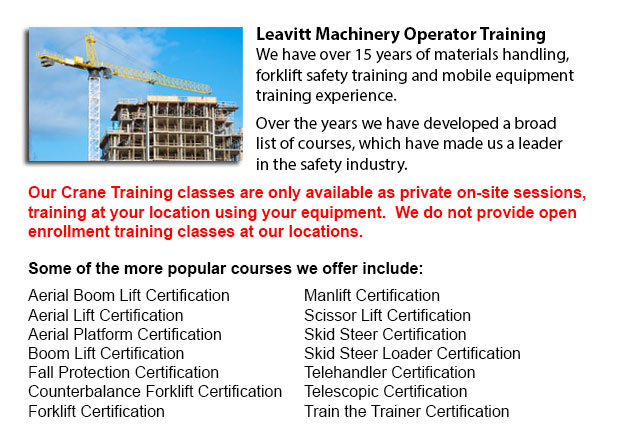
Prince George Overhead Crane Operator Training - Our overhead crane operator training course is intended to teach staff the fundamentals of overhead crane/sling operation and pre-shift inspections. Courses are taught by our professional trainers and consultants. Well-trained staff are more efficient and productive, that saves on costs connected with merchandise damage, property damage, and accidents because of the use of improper operating measures. Our overhead crane certification is customized for staff who have literacy barriers, reducing certification time by 50 percent.
Overhead cranes are best for specific repetitive lifting activities. This kind of crane has wide ranging capacities. They could be used for specialized lifting jobs such as installing or removing major plant equipment.
Operators and worker need to employ safe rigging practices in order to safely operate an overhead crane. This would need both knowledge and practice because the load needs to be properly rigged to ensure its stability when lifted. Before starting a lifting job, it must be determined that the crane is suitable for the job, with correct lift, capacity and travel. The crane must be subjected to a thorough physical and visual check before utilization. The capacity of all equipment, including the hardware, rope and slings, must never go beyond load weight capacities.
The rigger must know the correct sling for every lift and inspect slings and other rigging hardware prior to using. Clear signals have to be used in communications with the crane operator. A signaler has to be chosen for the role and signals need to be agreed upon. The operator of the crane should follow directions from the chosen individual only. If a remote or wired controller is being utilized, the operator should be trained in all its functions.
Prior to whichever lifting begins, the path of the load should be cleared of all hazards and a warning sign should be issued to ensure the safety of the staff. Pedestrian are not under any circumstance allowed to walk below the lift loads. The crane hoist should be centered over the load prior to lifting in order to prevent swinging. The safety catch needs to be closed instantly after sliding the sling fully onto the lifting hook. Sling legs that are not utilized must be secured so they do not drag. Never leave loose materials on a load being lifted. Watch that hands and fingers are clear when slack is taken out of a sling. Before the lift is carried out, step clear of the danger zone.
-
Prince George Telehandler Operator Training
Prince George Telehandler Operator Training - Telehandler forklifts or Telescopic Handler forklifts are common industrial machines found in various construction industry settings. The telehandler is a useful machinery and makes for a valuable tool wh... More -
Skid Steer Loader Certification in Prince George
The engine powered skid-steer loader comprises a small and rigid frame, equipped with lift arms that could attach to many industrial attachments and tools to execute several labor saving tasks. Normally, skid-steer loaders are four-wheel drive vehicl... More -
Prince George Telehandler License
Prince George Telehandler License - The telescopic handler or telehandler is a generally utilized machine in agricultural and industrial applications. This machine is the same in look to a forklift and also works in a similar manner, although telehan... More -
Prince George Manlift Ticket
Prince George Manlift Ticket - The Elevated Platforms and Manlifts Certification course helps to provide the needed training on the work practices, safe operating procedures, rules and regulations regarding the everyday activities for the operators o... More -
Prince George Manlift Operator Training
Prince George Manlift Operator Training - A specialized kind of hydraulic platform is referred to as an aerial lift or a man lift. It is designed to hoist an individual vertically up and down and thus, is likewise called a vertical personnel lift. Th... More -
Prince George Forklift Safety Training
Prince George Forklift Safety Training - Individuals wanting work in industries that utilize forklifts have to undergo a forklift safety training course prior to becoming a certified operator of a lift truck. There are many ways to go about obtaining... More -
Prince George Boom Lift Certification
Prince George Boom Lift Certification - The use o elevated work platforms allow for maintenance operations and work to be performed at elevated work heights which were otherwise unreachable. Workers making use of boom lifts and scissor lifts could be... More -
Prince George Crane Training Schools
Prince George Crane Training Schools - We have designed various programs for Mobile Crane Operation at our Crane Training Schools. These programs are recommended for the skilled operator who needs certification or re-certification, and for inexperien... More

Forklift Certification Prince George
TOLL FREE: 1-888-254-6157
Prince George, British Columbia
forkliftcertificationprincegeorge.com
Email Us
About Us


